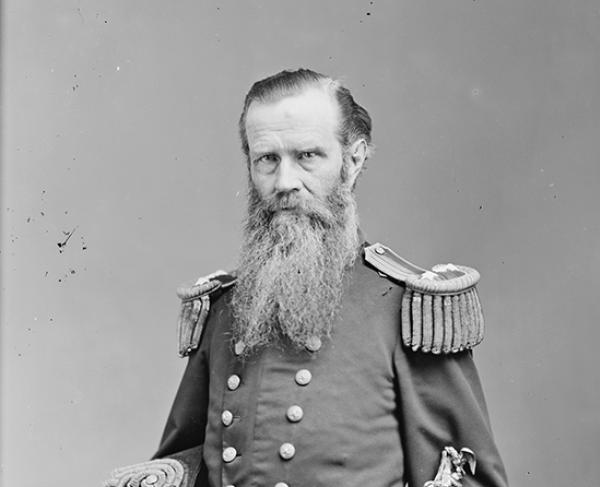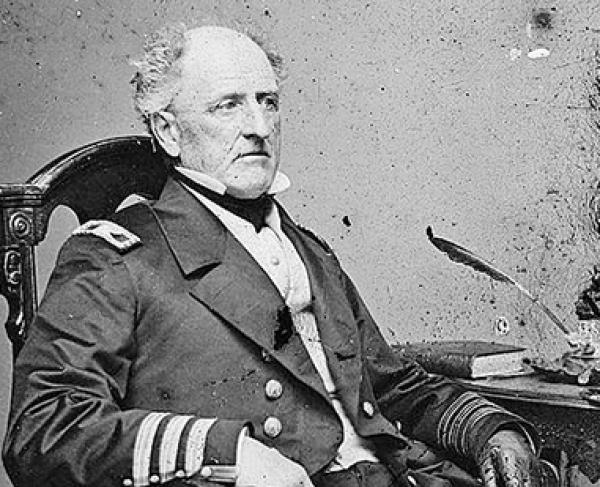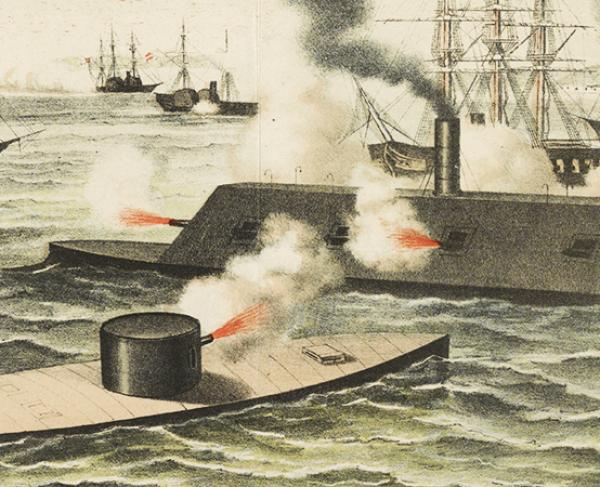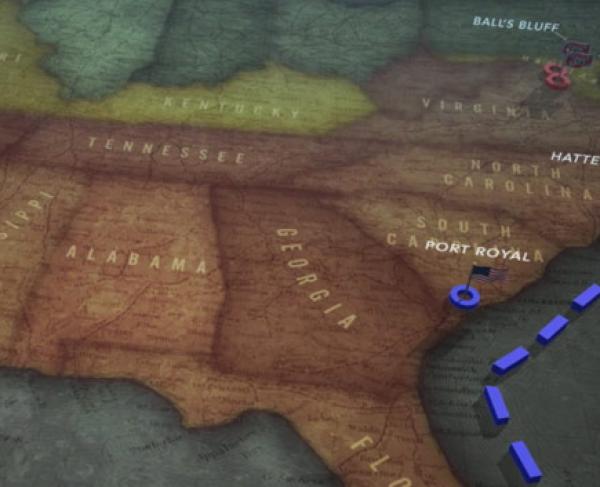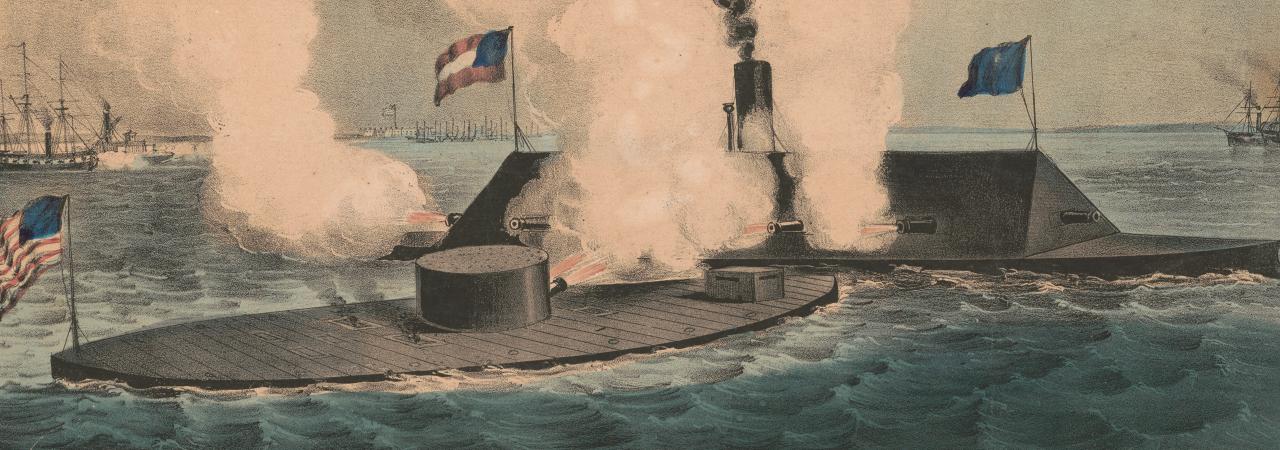
Hampton Roads
Monitor vs. Merrimack
Newport News, Norfok, and Portsmouth, VA | Mar 8 - 9, 1862
The Battle of Hampton Roads was the first engagement of ironclad warships during the Civil War and was fought between the USS Monitor and the CSS Virginia. While neither side could claim victory, the battle demonstrated the viability of ironclad technology and provided a glimpse into the future of naval warfare.
How it Ended
Inconclusive. The USS Monitor and CSS Virginia battled for hours before reaching a stalemate—neither carried the kind of armor-piercing shells necessary to pierce an iron hull. However, the Monitor halted Confederate threats to the Union blockade and prevented damage to the Federal fleet.
In Context
In the earliest weeks of the war, President Abraham Lincoln implemented a blockade off the southern coast, preventing Confederate trade, particularly the sale of cotton, with the outside world. Warships were needed to break the blockade, but the Confederates had few resources at hand. Confederate secretary of the Navy, Stephen Mallory, scrambled to find a solution. With no formidable vessels to choose from, Mallory decided instead to challenge the Union navy with the latest technology: warships clad with iron.
To achieve this goal, the Confederates sought to take advantage of what the Yankees left behind. After Virginia seceded in April 1861, many of the ships and repair facilities of the U. S. Navy at the Gosport Naval Yard in Portsmouth were hastily sunk or destroyed by retreating Union forces. The USS Merrimack had been scuttled and her upper works destroyed by fire. The Confederates raised Merrimack from the mud of the Elizabeth River, moved her into an undamaged graving dock, and transformed her into a heavily armed ironclad vessel. They rechristened the ship the CSS Virginia.
News of the Virginia caused panic in Washington. The Union navy quickly had to come up with their own answer to the ironclad warship. And they succeeded. A new and innovative warship silently slipped into Hampton Roads during the night of March 8, 1862. The USS Monitor, a steam-powered ironclad with a revolving gun turret, was the radical invention of John Ericsson. Commanded by Lt. John L. Worden, it was prepared to defend the rest of the Federal fleet from the seemingly invincible Confederate monster. While the battle was inconclusive, the Monitor’s action’s prevented the destruction of the Union navy.
The Merrimack’s machinery is restored, and her wooden superstructure is replaced with an iron-covered citadel mounting 10 guns. To increase her threat, a 1,500-pound iron ram is attached underwater to her bows. By early March 1862, the renamed CSS Virginia, is ready for battle. Seeking to destroy Union blockading vessels in Hampton Roads, Virginia leaves Portsmouth on the morning of March 8 and steams downriver to attack the Union ships at anchor there.
The innovative Monitor is battle-ready and incorporates 40 patentable inventions. The ship is fitted out with two massive 11-inch Dahlgren guns. Its unique appearance earns it the nickname “cheesebox on a raft.” By March 8, the vessel arrives under tow from New York and seeks to engage the Virginia.
March 8. Under the command of Flag Officer Franklin Buchanan, Virginia heads straight for the sloop of war USS Cumberland off Newport News Point. Around 2:00 p.m., Virginia strikes the Cumberland with its ram, smashing a huge hole in Cumberland’s wooden hull. Virginia dislodges itself from Cumberland’s side, but the lethal iron ram breaks off. Cumberland goes to the bottom with her colors flying, taking 121 Union sailors down with her.
With one opponent vanquished, Virginia turns on the nearby USS Congress. Seeking to avoid the same fate that befell the Cumberland, the Congress runs aground nearby. Virginia pounds the frigate with its powerful broadsides. Unable to maneuver, Congress is quickly wrecked by Confederate gunfire and catches fire. Around 4:00 p.m., Congress lowers her flag. Hoping to accept Congress’s formal surrender, Buchanan, who has come out onto his ship’s upper deck under a white flag, is wounded by a musket ball fired from Union infantry ashore. With daylight waning and its captain needing medical attention, the Virginia halts its attack and returns to the safety of the Elizabeth River.
March 9. Lt. Catesby Jones, now in command of Virginia, prepares the Rebel ironclad for another assault. Steaming towards the steam frigate USS Minnesota, the Virginia begins to take her new victim under fire. As the Virginia approaches Minnesota, Jones notices a strange raft-like vessel by its side. With the Monitor now bearing down on the Virginia, the Confederate ironclad shifts its fire to this newcomer with the large, two-gun rotating iron turret. The two ironclads settle down to a close-range slug fest. Both ships noisily fire into each other with little effect, their shots glancing off their armored sides. Virginia at one point tries to ram the smaller Monitor, but the nimbler Union vessel turns sharply to avoid the blow.
After several hours of close combat, Worden, standing in the pilot house on the Monitor, is temporarily blinded when a shell from the Virginia explodes close by. The Monitor disengages and heads for the safety of shallow water where the deep-draft Virginia cannot follow. Despite its temporary advantage, the Virginia, short on ammunition and threatened by the outgoing tide, withdraws and heads for the safety of Portsmouth.
369
24
The world’s first battle between steam-powered, ironclad warships ends in a draw, but the impact on the future of naval warfare is profound. For the next few months, the Monitor remains in Hampton Roads protecting the Union fleet there. Virginia ventures out from Portsmouth occasionally but never confronts the Monitor again. With the threat from the Virginia neutralized, Union blockade operations from Hampton Roads are restored and Maj. Gen. George B. McClellan is free to advance his Army of the Potomac up the Virginia peninsula toward Richmond.
During the two-day battle, the Federal navy suffers 261 killed and 108 wounded in its struggle with the Virginia—more killed and wounded than in any other sea battle in American history at that time. March 8, 1862, would remain the bloodiest day in American naval history until December 7, 1941, when the Japanese navy struck the American fleet at Pearl Harbor.
The CSS Virginia was fairly conventional. Built upon the hull of the USS Merrimac, it was a wooden vessel covered with iron plates, and it had fixed weapons. Still, she was a formidable threat. Iron covered, the ship measured 275 feet long 38.5 feet across its beam, and 27.5 feet deep. It was angled such that cannon shot would harmlessly bounce off its sides. Outfitted with ten guns and resembling a floating barn roof, the ship was rechristened the CSS Virginia and released from dry dock into the Elizabeth River on February 17, 1862.
The ship possessed a mixed armament consisting of two 7-in. Brooke rifles, two 6.4-in. Brooke rifles, six 9-in. Dahlgren smoothbores, as well as two 12-pdr howitzers. While the bulk of the guns were mounted in the ship's broadside, the two 7-in. Brooke rifles were mounted on pivots at the bow and stern and could traverse to fire from multiple gun ports. In creating the ship, the designers concluded that its guns would be unable to penetrate the armor of another ironclad. As a result, they had Virginia fitted with a large ram on the bow. Though a formidable vessel, Virginia's size and balky engines made it difficult to maneuver and complete circle required a mile of space and forty-five minutes.
When federal authorities discovered in the summer of 1861 that the Confederates were armoring the old Merrimac, they knew they had to commission a unique vessel of their own to challenge her. USS Monitor, was commissioned on February 25, 1862 at New York City, New York. An innovative warship, she had a thick-armored round turret which was twenty-feet in diameter. Rotated by steam power, the turret could fire nearly 360 degrees from a pair of eleven-inch Dahlgren smoothbore shell guns.
The Monitor had a round, rotating gun turret on her deck. The iron turret housed two Dahlgren guns, installed side by side. Innovative in design as well as in construction, the Monitor had components and attributes that were later echoed in submarine design. Her armored deck, 172 feet long and 41.5 feet at the beam, rode just 18 inches above the waterline and extended beyond the hull, which was only 5/8-inch thick and thus nearly submerged for protection against cannon fire. On the deck with the gun turret was a small pilothouse and a detachable smokestack. The turret was made from eight layers of 1-inch iron plate bolted together. A ninth plate within the turret provided a sound barrier.
Although born and raised in Sweden, John Ericsson (1803 –1889) eventually immigrated to America where in 1861, he signed a contract with the U.S. Navy to build an ironclad vessel. At the outbreak of the Civil War, both the Union and Confederacy began experimenting with ironclad warships. As the Confederacy began converting the captured USS Merrimac into the ironclad CSS Virginia, Ericsson began working on the Union's answer.
Ericsson's contract stipulated that if his design failed, he would have to return his payment for the ship to the U.S. government, but he didn't care, since he was doing the ship out of love for America. "I love this country, I love its people and its laws; and I would give my life for it just as soon as not," he explained.
Fortunately, no repayment was necessary. Ericsson's design, conceived eight years earlier and presented to Napoleon III of France (who, though impressed, did nothing to develop the concept) included his invention of the "screw" propeller, a low silhouette, and revolving two-gun turret, and was a success. Although its famous four-hour duel with the Virginia at the Battle of Hampton Roads in March 1862 was a tactical draw, the Monitor prevented the destruction of the Union fleet at Hampton Roads. After the battle, the Navy ordered another 56 of Ericsson's "monitors," as the design came to be known.
Ericsson's engineering works were numerous, and in addition to the Monitor, he is also best known for his circa 1829 design of the Novelty steam locomotive, built with partner John Brathwaite in England.
His achievements revolutionized naval warfare and gained him international recognition.
Hampton Roads: Featured Resources
All battles of the Peninsula Campaign
Related Battles
1,400
188
369
24
